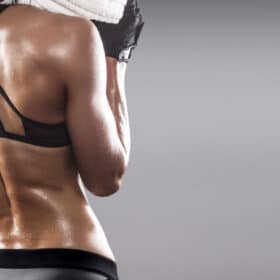It is in the nature of things that athletes prefer to train those muscle parts that visually make the most impression, which primarily applies to the chest, shoulders and upper arms. However, in order to prevent injuries and to guarantee maximum mobility and resilience, a uniformly developed musculature is indispensable. The adductors are one of the muscles that are often left out, or at least neglected, despite extensive 4-split plans. In this article we'll explain why you should train the inner thighs, better known as the Adductor training should not neglect and, in addition, which exercises strengthen this injury-prone muscle area.
Why is targeted adductor training useful?
The reasons why you should train your adductors at least once in a while are manifold, because the muscle strands on the inner side of your thighs not only serve to stabilize the entire leg, but also represent a limiting factor in the context of complex basic exercises such as squats or deadlifts, which only a few people take into account. If the adductors (M.adductor magnus, M.adductor longus, M.adductor brevis), which are responsible for pulling the thigh towards the center of the body, are too weakly developed, the risk of muscular injuries such as torn muscle fibers or even torn muscle bundles also increases, which may deprive you of the reward of a training program lasting several weeks. This risk is particularly prevalent for those who spend a large part of their free time on the soccer field, as the sport of soccer trains the abductors, which are responsible for spreading the thigh, to a disproportionately high degree compared to the adductors. To test whether you also have such a muscular dysbalance, lie flat on your back with your legs stretched out, wedge a medium-weight medicine or exercise ball between your feet and lift it for a few seconds. If you find the exercise difficult, you should integrate your adductors into your training plan not just sporadically, but regularly.
Sumo Squat & Side Lunge
Even though classic squats also put the adductors under tension, supplementary exercises are nevertheless necessary to achieve an optimal result. Sumo squats are therefore an optimal extension of your workout, as most of the tension is applied to the inner thigh during execution. With the exception of the foot position, the execution is basically similar to the classic squats, so you will have internalized the technique after just a few repetitions. In contrast to the normal squat, your feet are in a slightly more than shoulder-width position with the tips of your feet slightly rotated outward, although you should make sure that there is only minimal rotation in the knee itself, otherwise it will be unnecessarily stressed. The different starting position also implies that the apex of the movement is already reached when your thighs are parallel to the floor. Along with the sumo squat, the lateral barbell lunge is one of the most effective exercises for the adductors. Once you have lifted the barbell from the rack and positioned yourself, perform a lateral lunge, making sure that while you perform as wide a step as possible, your foot is always in line with the knee joint to avoid injury. It is also important to maintain tension in the back at all times so that the intervertebral discs are not overloaded.
Diagonal lunge & adductors on the machine
Diagonal lunges are also an effective way to strengthen the inner thighs. Start by placing your feet shoulder-width apart on the floor and then take a wide diagonal step forward until you feel a pull on your inner thigh. Finally, push yourself back to the starting position with strength but without momentum and repeat the exercise with your other leg. To make the execution a bit more challenging, we recommend the variable use of dumbbells as additional weight. Even if the classic adductor machines seem rather strange to most male athletes due to the prominent starting position, they are a valuable alternative to the exercises described above, as you can consciously focus on your adductors while performing them. In this context, however, you should keep your training weight as low as possible and primarily place value on high-quality execution in order to benefit from adductor training in the long term. If you still don't want to get involved with such a device, you can equally train your adductors on the cable pulley by hooking your foot into a handle or using a foot sling for fixation.
Conclusion - Adductor training pays off
As you can see, training the adductors is much more than a nuisance, as you're actively helping your body establish muscular balance, which significantly reduces your susceptibility to injury and effectively compensates for imbalances. In addition, targeted adductor training can help you perform significantly better in the context of other exercises due to more dynamic intermuscular coordination.




